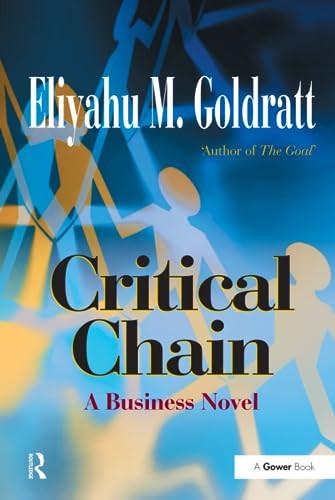Rishekesh Ramesh's Key Ideas from Critical Chain
by Eliyahu M. Goldratt
Ideas, facts & insights covering these topics:
11 ideas
·850 reads
2
Explore the World's Best Ideas
Join today and uncover 100+ curated journeys from 50+ topics. Unlock access to our mobile app with extensive features.
Preamble
Critical Chain Project Management is a project management methodology defined as a set of interlinked techniques and tools that work collaboratively to significantly improve the processes and operation of scheduling and execution in project, program, and portfolio environments.
Eliyahu Goldratt developed CCPM. Goldratt had been working on improving factory efficiency and advocated identifying production bottlenecks and focusing on keeping production operating at maximum efficiency. Goldratt extended his work beyond factories and into project management, publishing ‘Critical Chain' in 1997.
10
124 reads
Key Problems that the CCPM Methodology Tackles
Tasks often take longer than the estimated time, but very rarely get delivered early. Goldratt cites three reasons for this:
- Student Syndrome
- Dependencies
- Parkinson’s Law
9
106 reads
Student Syndrome
This truism suggests that most people do not fully apply themselves to activities until at least half the time allocated has elapsed. This idea of planned procrastination has been backed by research and appears to be entirely normal behavior. But it does mean that any margin for error is removed, resulting in a tendency for work to be completed late, no matter how much time has been allocated.
11
89 reads
Dependencies
When several workstreams on a project come together into a single dependent activity, that dependent activity cannot start until all of the preceding workstreams have been completed. This means that if you have five workstreams all coming together for (for example) an end-to-end system test phase, then even if 4 of the 5 streams finished early, the testing will still start late if the fifth stream is delayed.
10
79 reads
Parkinson’s Law
Attributed to C. Northcote Parkinson, Parkinson’s Law on the pursuit of progress states that work expands to fill the time available for its completion.
10
78 reads
Aggregating Contingency - Factoring in Considerations
Given what we know of Student Syndrome and Parkinson’s law, adding contingency to tasks on a project simply results in the project delivering later. Often, contingency is mentally factored in by people working on the project, they will start fully applying later than normal when there is an understanding that contingency exists. This can end up with situations where adding contingency not only makes delivery later, but the contingency is actually over-run, and projects get even later. For this reason, CCPM usually requires specialist software to calculate and keep track of the time buffer.
9
67 reads
Remaining Duration Reporting
When using the CCPM, we avoid focusing on milestones for delivery. Instead, we focus on encouraging and rewarding behaviors that lead to the delivery of critical activities as fast as possible. This requires a change of reporting and a change in mindset. To avoid Parkinson’s law, we focus on delivering as fast as possible, rather than focus on milestone dates. Rather than getting updates in terms of percentage complete, we ask for estimates of ‘Remaining Duration’. Reporting in this way provides a more realistic picture of when activity is likely to complete and prevents late-emerging issues
11
61 reads
Feed Buffers : Averting Dependencies
The Critical Chain model introduces Feed Buffers for the noncritical chain. Feed buffers are not included in the overall Project Buffer but are used as a way of insulating the critical path of the project from non-critical workstream elements. By building in Feed Buffers, CCPM reduces the risk of projects overrunning due to dependencies.
9
59 reads
Fever Charts : Assessing Project Performance
CCPM introduces a new type of chart to track projects, The Fever Chart
The fever chart plots the percentage of the Project Buffer that has been consumed against the percentage of the critical chain that has been completed. Progress is plotted as a line graph, giving a running commentary of how the project is performing. This can be applied in program and portfolio levels as well, as a diagnostic tool.
9
61 reads
CCPM on Multitasking
CCPM is very clear on its views on multitasking. It advocates for strict discipline where no one working on a critical path activity should be working on anything else at the same time. Eliminating multitasking can have a significant impact on productivity.
11
57 reads
Since the strength of a chain is determined by the weakest link, then the first step to improve an organisation must be to identify the weakest link.
ELIYAHU GOLDRATT
10
69 reads
IDEAS CURATED BY
CURATOR'S NOTE
Dissecting the core of this business management novel : Critical Chain Project Management (CCPM) Methodology
“
Discover Key Ideas from Books on Similar Topics
10 ideas
Common Sense
Thomas Paine
15 ideas
The CIO's Guide to Breakthrough Project Portfolio Performance
Michael Hannan, Wolfram Muller, Hilbert Robinson
2 ideas
Read & Learn
20x Faster
without
deepstash
with
deepstash
with
deepstash
Personalized microlearning
—
100+ Learning Journeys
—
Access to 200,000+ ideas
—
Access to the mobile app
—
Unlimited idea saving
—
—
Unlimited history
—
—
Unlimited listening to ideas
—
—
Downloading & offline access
—
—
Supercharge your mind with one idea per day
Enter your email and spend 1 minute every day to learn something new.
I agree to receive email updates











